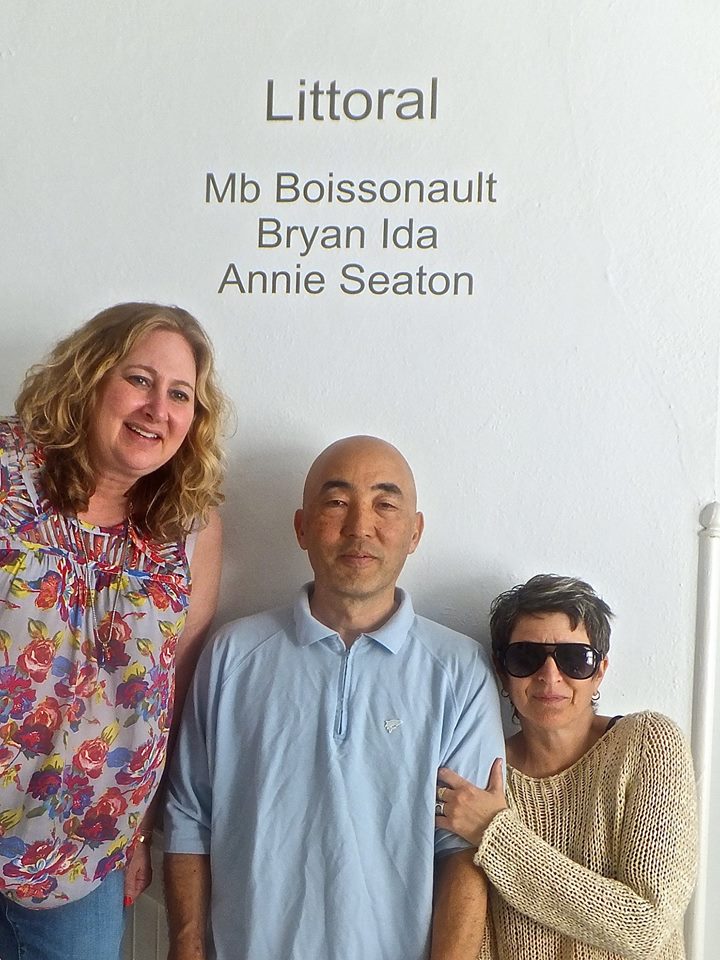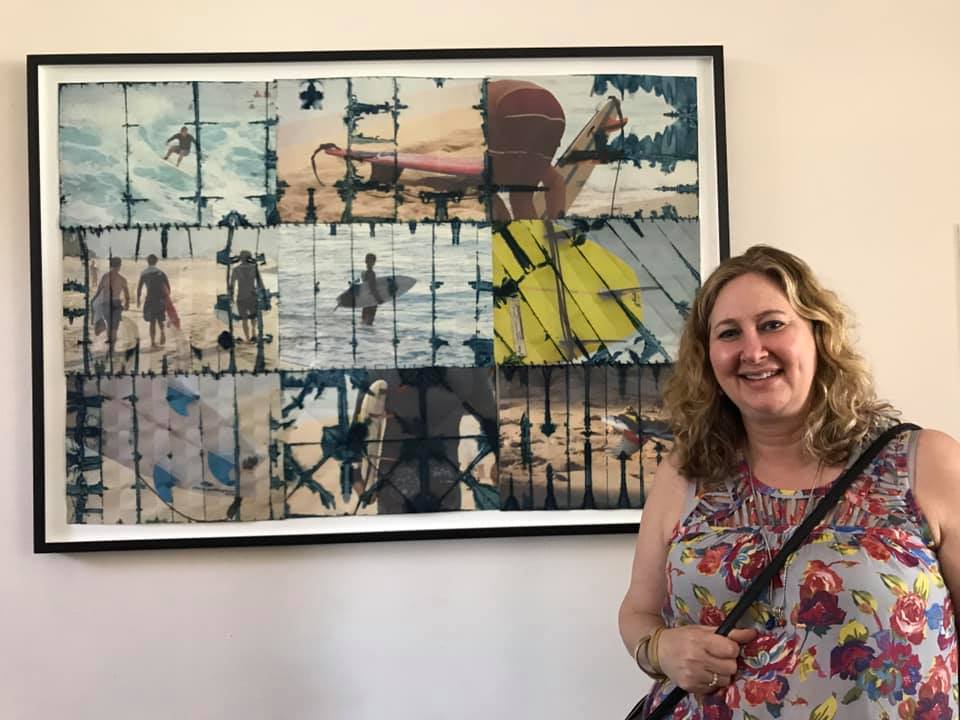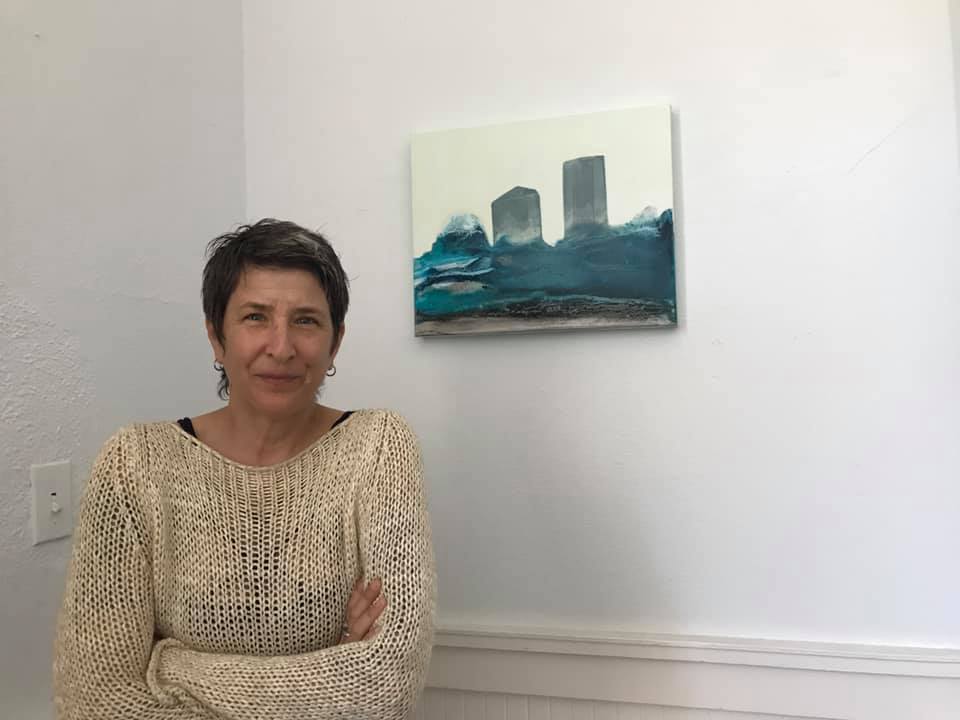Life of Change, a retrospective exhibition of artist Bryan Ida now at the Bakersfield Museum of Art, offers an immersive art journey, the destination still on-going. Ida is a master artist, working in a wide range of mediums and styles throughout the years. As skillful and powerful as this show is, it is just a small sampling of the art Ida has created through multiple mediums and series.
His varied career is packed with treasures, which unfold initially in chronology, blending seamlessly into a mix of works from throughout the latter half of his career so far. As curated by the museum’s Victor Gonzales, the works speak well to each other in terms of palette and detail.
Whether working in oil, acrylic, or ink, on paper, canvas, or panel, Ida’s skill is thrilling to observe, his subjects rich and deep. There are whimsical works – a lively, communicative chicken, a triptych of floating, joyous flowers; cosmic and ethereal abstracts; and urgent, imperative messaging about ecology, culture, and human cruelty and human purpose.
Spreading over the two largest rooms in the spacious, modern museum, Ida’s works lead the viewer through changes of their own, even as they follow the shifts in the artist’s approach and subjects, moving from 1993 to 2023.
Ida’s contemporary art career began with the study of electronic music composition, but his artistic passion shifted to visual art working side by side with abstract expressionist Sam Francis, whose style he emulated during the first five years of painting. He continues to embody Francis’ love of light, color, and movement, even as his work has dramatically morphed to embody so many other approaches and forms.
A California native of Japanese American heritage, Ida’s work is both free floating and meticulous, moving in his most recent works between portraits of people affected by society’s discrimination and ills in mesmerizing, highly detailed black and white, to vivid acrylic works examining the adverse effects of human life on flora and fauna throughout earth’s ecosystem.
Viewers will experience the circular acrylic on canvas “Untitled” from 1995, in which splashes of color are carefully conjoined by lines, and a mix of fierce deep green, yellow, midnight blue, and bright orange spill together like a mix of autumnal and spring leaves. Switching to oil, a 1996 “Untitled” work is oil on paper, dense and delicate, blues and golds and white married by a weaving of bold, black, almost representational lines (profiles, moons?) and dots and splashes of color in an exploration of his then-new medium that’s sinuous and explosive all at once.
There are abstract works in black and white, too, and smaller, vivid pieces that resemble planetary explosions, a red volcano in a blue sky, or intricate plant life in a green and blue work ribbed with light.
Moving onto Ida’s Renaissance Series in the late 1990s, viewers are treated to works like “Impermanence,” in which layers of paint glow with luminosity, including a technique the artist created layering a mix of colors to create a black that glows from within like obsidian in sunlight. It’s extremely unusual to see black as a color that’s opalescent, and yet that is what one sees in this piece, which mingles the rich black with blue and orange and gold and green to create an abstract work that holds light the way that stained glass will when sunlight strikes it. The shapes here are almost human, or like the fire spirits one can see dancing in the flames of a campfire.
From the same period, viewers will also experience pieces like “Take Five,” in which river stones are shaded with blues and greens against a black surface, thin paint streaking over them like the water dancing over the rocks that inspired the work.
Ida’s Lights series, from later in this same period, explores techniques such as glazing and layering, varying color to embody a wide range of huges and shadow within each work. “Green Lights 2” is such a piece, and speaks to a dimension beyond our own, and the outer reaches of space and comprehension.
Becoming representational, Ida created worked such as those in his Leaves series of 2001. “Autumn Leaves” is a burnished delicate mix of browns, oranges, and golds against a pale blue reminiscent of a November sky. The oil on canvas work, like each image of Ida’s, contains a translucent, almost ephemeral beauty.
So too does the exhibition’s representation of the artist’s Funny Animals series from the same time – a large scale oil on canvas work titled “Buck Why” gives us a talkative, gold-orange and blue-green chicken with a radiant red comb.
The early 2000s also saw Ida experimenting with cold wax mixed with oil paint, in which this intense perfectionist created astoundingly intricate works such as “Talisman II.” The technique used in this piece involved essentially carving into the painting, sanding the surface, revealing a series of fine lines seemingly impossible to create. It is both woven lace and spider web, but more free of form.
From later in this decade, viewers can take in works such as Ida’s “Generation One,” a vivid blue oil on panel with a grid that looks like a fishing net, with squirming small orange and gold fishes suspended on it, inspired by Ida’s own experiences fishing.
His Cityscapes series (2014-2017) is intensely geometric, using acrylic on panel and thick layers of epoxy, creating glossy and layered futuristic landscapes that pulse with energy, such as “China Basin.”
The artist’s Water series, from the same period, provides an equally layered and geometric view of man’s relation to water, seething with current-like motion.
Ida’s most recent works include those in his Con.text series, ink on panel, black and white works that take the artist’s recreation of minute words to shape the texture and form of full-body portraits. Intimate, even heartbreaking, and uniquely powerful, we see images including “Neighbor,” 2018’s depiction of a Muslim woman who was headed to worship at her mosque. Ida uses the text of Trump’s hateful 2017 tweets to form the image’s shading and textures, a highly personal critique of the cruelty of the words, and the humanity of his subject. This series offers profound work, intuitively passionate. It includes images of Ida’s late brother, “Blaine,” composed of text from the NRA bylaws; his father as originally captured in a Dorothea Lange photograph bound for a “relocation camp” during World War II, and “Mary Jo,” the text of which uses two sources to powerfully comment about a woman’s right to choose.
Ida’s other current series, Nature, uses a vivid acrylic palette to depict the relationship between humans and nature. He has animals and landscapes layered within layers, as if a screen of human-making separated our view of the natural world. “Sunset Desire” is an incredible piece, in which we are divided from our view of, in Ida’s own words, “A sunset, a dark forest, the depth of the ocean’s edge” yet we are inextricably linked “there exists a balance and interconnectedness between humanity and nature.”
It’s hard to express the monumental emotional effect Ida’s work creates. While it is fair to say that his work grows more powerful each year even as he shifts subjects and approaches, each image exudes a profound sense of beauty and wonder, a realization of the fragility of the world and its grandeur. Ida is an artist’s artist, working so many hours a day on his detailed Con.Text series that a nerve injury developed in his wrist. Yet the artist has not let that stop him, even as he heals – he has become ambidextrous and continues to create compelling works that drive the eye and piece the heart.
Speaking of driving – make a drive to Bakersfield. The exhibition runs through January 6th, and BMOA is open Tuesday-Saturday 10 a.m. to 4 p.m. An exhibition tour will take place December 16th. This is singular work, and an event to be relished.
- Genie Davis; Photos by Genie Davis and provided by the artist




































































